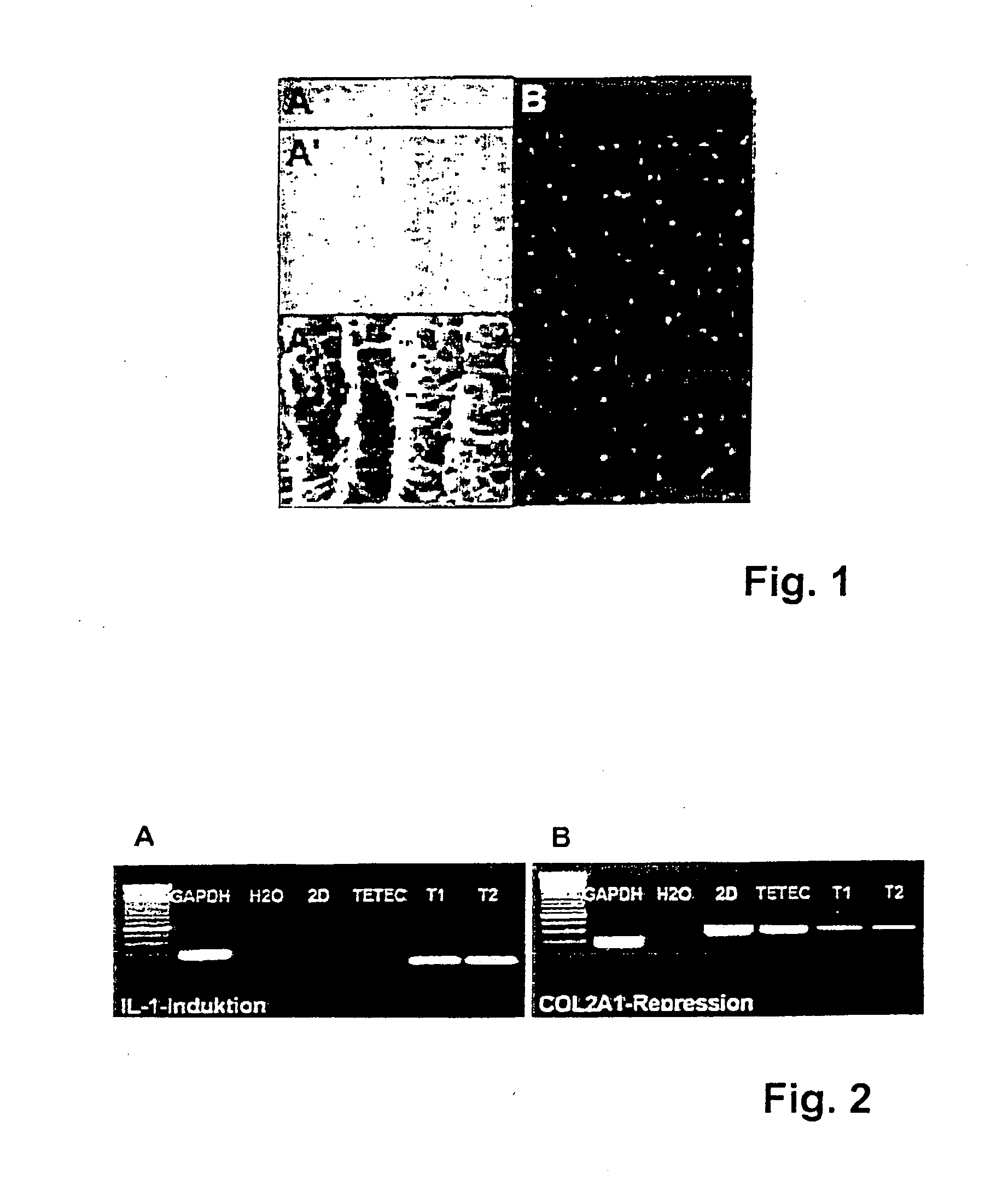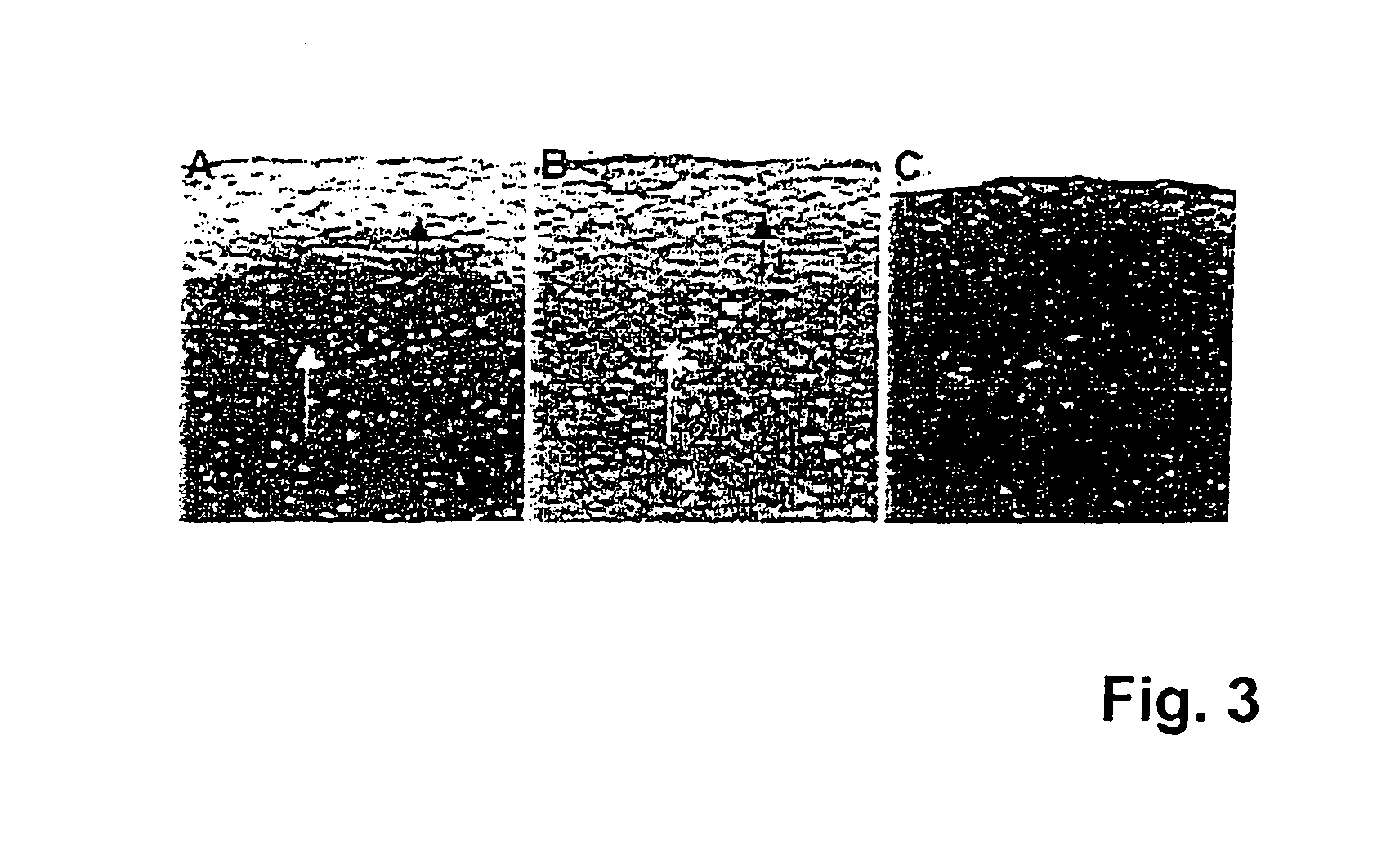Implant for repairing a cartilage defect
a cartilage defect and implant technology, applied in the field of cartilage defect repair implants, can solve the problems of cartilage defects that cannot be repaired, cartilage defects are associated with pain, cartilage defects are not easy to heal, and achieve the effect of effective and reliable treatment for cartilage defects
- Summary
- Abstract
- Description
- Claims
- Application Information
AI Technical Summary
Benefits of technology
Problems solved by technology
Method used
Image
Examples
example 1
Preparation of an Implant According to the Invention
[0079] An implant according to the invention can be prepared—for example—by a method disclosed in EP 1 275 405. By using this method a sponge-like layer or protein matrix can be anchored in a membrane-like layer. Briefly, a membrane-like layer was provided comprising collagen—other suitable materials are, e.g., bioresorbable polymers such as polylactide or polyglycolic acid, collagen, pericardium, composites, glycosaminoglycanes, natural tissue sources like elastin, and mixtures of two or more of these materials. The sponge-like layer was applied thereon in form of a suspension. Alternatively it can be supplied as a dispersion or paste. The suspension was comprising collagen—other materials can be used, e.g. hyaluronic acid, alginate, chitosan, gelatine, processed materials, composites, blood born components such as fibrin, and mixtures of two or more of these materials—and was introduced into the membrane-like structure by means ...
example 2
[0084] With respect to the biocompatibility of the implants, induction of Interleukin IL-1 expression and reduction of collagen type II expression of chondrocytes seeded into different implants was assessed in vitro.
[0085] The results of these tests are shown in FIG. 2. In FIG. 2A (“IL-1 Induktion”) it is shown that IL-1 induction in chondrocytes seeded on an implant according to the invention (“TETEC”) is lower than IL-1 expression in chondrocytes seeded on commercially available implants (“T1” and “T2”). When IL-1 expression was increased hypertrophy and degeneration of chondrocytes seeded into the implants could be observed in vitro. A marker and controls “GAPDH” and “H2O” are displayed in lanes 1 to 3 respectively.
[0086] Further, expression of collagen type II, which is an essential structural protein in cartilage, was remarkably reduced in chondrocytes seeded into commercially available implants (“T1” and “T2”) in comparison to chondrocytes seeded into implants according to t...
example 3
[0087] The implant prepared as mentioned above (see Example 1) was tested in animal studies. Experiments were conducted in SCID (“severe combined immunodeficiency”) mice, into which human cells can be transplanted without rejection of these cells, since in the mentioned mice the enzyme adenosine deaminase is deficient and—as a result—T or B cells are not being developed.
[0088] It was previously shown in SCID mice that human articular chondrocytes do only produce solid hyaline cartilage when the transplanted cells express certain marker genes, the fact of which has to be proofed in molecular / biological quality assays. Chondrocytes not expressing collagen type II, BMP-2 (bone morphogenetic protein 2) and FGFR-3 (fibroblast growth factor receptor 3) any more are not able to regenerate high quality cartilage.
[0089] In test group A, human articular chondrocytes expressing relevant marker genes were seeded on an implant according to the invention (5×105 cells / cm2 carrier layer, i.e. sec...
PUM
| Property | Measurement | Unit |
|---|---|---|
| Length | aaaaa | aaaaa |
| Length | aaaaa | aaaaa |
| Length | aaaaa | aaaaa |
Abstract
Description
Claims
Application Information
 Login to View More
Login to View More - R&D
- Intellectual Property
- Life Sciences
- Materials
- Tech Scout
- Unparalleled Data Quality
- Higher Quality Content
- 60% Fewer Hallucinations
Browse by: Latest US Patents, China's latest patents, Technical Efficacy Thesaurus, Application Domain, Technology Topic, Popular Technical Reports.
© 2025 PatSnap. All rights reserved.Legal|Privacy policy|Modern Slavery Act Transparency Statement|Sitemap|About US| Contact US: help@patsnap.com


